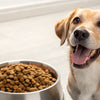Is Grain-Free Kibble Better for Dogs? Understanding the Benefits and Risks
- Houndsy
Table of Contents
- Introduction
- The Evolution of Grain-Free Diets
- The Benefits of Grain-Free Kibble
- Potential Risks and Concerns
- Making the Switch: What to Consider
- Conclusion
Introduction
Imagine this: You’re standing in the pet food aisle, surrounded by colorful bags touting health benefits and promises of vitality for your beloved canine companion. As you scan the options, your eyes land on a bag labeled “grain-free.” With a surge of curiosity, you wonder, is grain-free kibble better for dogs? It’s a question that resonates with many pet parents who want the best for their furry friends.
In recent years, the rise of grain-free dog food has sparked conversations about what constitutes a healthy diet for dogs. With various claims about improved digestion, enhanced energy levels, and fewer allergens, it’s easy to get swept up in the marketing hype. But what does the science say? Understanding the implications of switching to a grain-free diet is crucial for making informed decisions about our pets' health.
In this blog post, we’ll delve deep into the world of grain-free kibble, exploring its potential benefits and risks. By the end, you’ll have a clearer understanding of whether grain-free diets are suitable for your dog and how to navigate the vast choices available in pet nutrition. Furthermore, we’ll examine how high-quality feeding solutions, like the Houndsy Kibble Dispenser, can enhance your dog-feeding experience while ensuring your pet’s health and happiness.
The Evolution of Grain-Free Diets
Grain-free diets emerged over two decades ago, initially designed to address food allergies in pets. Veterinarians and nutrition experts developed these diets to eliminate common allergens typically found in grains such as wheat, corn, and barley. By 2005, grain-free options gained traction, marketed as healthier alternatives with fewer fillers.
However, the notion of grain-free diets being inherently superior remains contentious. While many dogs handle grains well, some may benefit from a grain-free approach. To navigate this landscape, it’s essential to consider several factors, including individual dog health, nutritional balance, and ingredient quality.
What is Grain-Free Dog Food?
Grain-free dog food is formulated without common grains, instead relying on alternative sources of carbohydrates, such as legumes, potatoes, and other vegetables. These foods are designed to provide adequate nutrition while avoiding ingredients that some dogs may be sensitive or allergic to.
Understanding Ingredients and Nutritional Balance
When evaluating grain-free options, it’s vital to look beyond the absence of grains. A healthy dog diet should contain a balanced mix of proteins, fats, carbohydrates, vitamins, and minerals. Here’s a breakdown of common ingredients found in grain-free kibble:
- Proteins: Quality animal proteins are crucial for muscle development and overall health. Look for ingredients like chicken, beef, or fish as the primary protein source.
- Legumes and Pulses: Ingredients like peas, lentils, and chickpeas serve as alternative carbohydrate sources while providing protein and fiber.
- Vegetables: Sweet potatoes, carrots, and other vegetables contribute fiber, vitamins, and minerals necessary for optimal health.
- Fats: Healthy fats, such as fish oil, support skin and coat health, as well as overall energy levels.
The Benefits of Grain-Free Kibble
Transitioning to grain-free kibble can offer several potential benefits for dogs, particularly for those with specific sensitivities or dietary needs. Here are some key advantages:
1. Improved Digestion
Many dogs experience digestive issues stemming from the consumption of certain grains. Grain-free kibble often contains more digestible carbohydrates that can alleviate bloating, gas, and irregular bowel movements. Ingredients like sweet potatoes are high in dietary fiber, promoting better digestive health.
2. Reduced Allergic Reactions
Grain allergies, though relatively uncommon, can cause discomfort for some dogs. By eliminating grains, pet owners may reduce the chances of triggering an allergic response. However, it’s crucial to note that other allergens, including certain proteins, can also provoke reactions.
3. Enhanced Skin and Coat Health
A grain-free diet can contribute to a shinier coat and healthier skin. High-quality fats and proteins found in grain-free kibble nourish the skin, potentially reducing itchiness and flakiness associated with grain consumption.
4. Increased Energy Levels
Grain-free kibble often incorporates complex carbohydrates that provide sustained energy release. This helps prevent the spikes and crashes associated with simpler, grain-based carbohydrates. Many pet owners report their dogs exhibiting more consistent energy levels when fed grain-free diets.
5. Nutritional Balance
Grain-free dog foods typically emphasize high-quality ingredients and avoid fillers. This results in a more nutritionally balanced diet, supporting overall health and vitality. Dogs can benefit from a diverse array of nutrients, ensuring robust immune function and physical well-being.
Potential Risks and Concerns
While there are benefits to grain-free diets, pet owners should also be aware of the potential risks. Here are some important considerations:
1. Dilated Cardiomyopathy (DCM)
Recent studies have raised concerns about a possible link between grain-free diets and dilated cardiomyopathy (DCM), a serious heart condition. Certain breeds, including Golden Retrievers and Doberman Pinschers, have been particularly affected. The FDA has investigated these cases, noting that many affected dogs consumed diets high in peas, lentils, and potatoes—common ingredients in grain-free kibble.
2. Nutrient Deficiencies
Some grain-free diets may lack essential nutrients that grains typically provide. For instance, taurine, an amino acid important for heart health, has been found deficient in some grain-free formulations. Dogs with specific dietary needs may require more careful management to ensure they receive all necessary nutrients.
3. Allergies to Alternative Ingredients
Just because a food is grain-free doesn’t mean it’s hypoallergenic. Many dogs can develop allergies to alternative ingredients commonly found in grain-free diets, such as peas and potatoes. Monitoring your dog’s response to any new food is essential to ensure it suits their unique requirements.
4. Misleading Marketing
Pet food labeling can often be misleading. Terms like “natural” or “premium” may not always equate to higher quality. As responsible pet owners, we must scrutinize ingredient lists and seek out brands that prioritize quality and transparency.
Making the Switch: What to Consider
If you’re contemplating a switch to grain-free kibble, here are some steps to ensure a smooth transition:
1. Consult Your Veterinarian
Before making dietary changes, consult your veterinarian. They can help determine whether a grain-free diet is appropriate for your dog based on their health, age, breed, and activity level.
2. Gradual Transition
When switching to a new food, a gradual transition is crucial to avoid upsetting your dog’s digestive system. Mix the new grain-free kibble with their current food over several days, gradually increasing the proportion of the new kibble.
3. Monitor Your Dog’s Response
As you transition to grain-free kibble, keep an eye on your dog’s health and behavior. Look for changes in digestion, energy levels, and skin condition. If any adverse reactions occur, consult your veterinarian promptly.
4. Choose Quality Brands
Not all grain-free kibbles are created equal. Look for brands that prioritize high-quality ingredients, avoid fillers, and undergo rigorous testing. Our flagship product, the Houndsy Kibble Dispenser, ensures you can feed your dog consistent portions of high-quality kibble, making feeding a joyous and stress-free experience.
Conclusion
The question of whether grain-free kibble is better for dogs is multifaceted. While it can offer advantages for certain dogs, particularly those with specific sensitivities, it’s crucial to approach the decision thoughtfully. Understanding the potential benefits and risks allows us to make informed choices that prioritize our pets' health and well-being.
As you explore feeding solutions for your furry friend, consider how the Houndsy Kibble Dispenser can enrich your dog-feeding routine. With its elegant design and functionality, it elevates the feeding experience, ensuring your pet receives the best nutrition while you enjoy the convenience and beauty of modern pet care.
FAQ
1. Is grain-free food necessary for all dogs?
No, not all dogs require grain-free diets. Many dogs thrive on diets that include grains. Consult your veterinarian to determine the best diet for your dog.
2. Can grain-free food cause heart problems in dogs?
There have been reports linking grain-free diets to dilated cardiomyopathy (DCM) in certain breeds. It's essential to monitor your dog and consult your veterinarian if you have concerns.
3. What are the symptoms of food allergies in dogs?
Common symptoms include itching, skin irritations, digestive upset, and changes in behavior. If you suspect your dog has a food allergy, consult your veterinarian for appropriate testing and dietary recommendations.
4. How can I ensure my dog is getting complete nutrition on a grain-free diet?
Choose high-quality grain-free foods that list balanced ingredients and consult your veterinarian for guidance on your dog's specific nutritional needs.
5. What should I look for in a high-quality dog food brand?
Look for brands that prioritize whole ingredients, provide transparency in sourcing, and have undergone feeding trials. Avoid those with excessive fillers or vague marketing claims.












